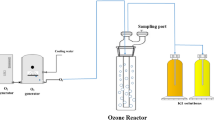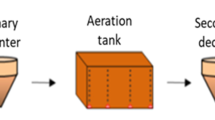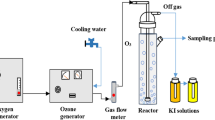Abstract
This study investigated the inactivation of two antibiotic resistance genes (ARGs)—sul1 and tetG, and the integrase gene of class 1 integrons—intI1 by chlorination, ultraviolet (UV), and ozonation disinfection. Inactivation of sul1, tetG, and intI1 underwent increased doses of three disinfectors, and chlorine disinfection achieved more inactivation of ARGs and intI1 genes (chlorine dose of 160 mg/L with contact time of 120 min for 2.98–3.24 log reductions of ARGs) than UV irradiation (UV dose of 12,477 mJ/cm2 for 2.48–2.74 log reductions of ARGs) and ozonation disinfection (ozonation dose of 177.6 mg/L for 1.68–2.55 log reductions of ARGs). The 16S rDNA was more efficiently removed than ARGs by ozone disinfection. The relative abundance of selected genes (normalized to 16S rDNA) increased during ozonation and with low doses of UV and chlorine disinfection. Inactivation of sul1 and tetG showed strong positive correlations with the inactivation of intI1 genes (for sul1, R 2 = 0.929 with p < 0.01; for tetG, R 2 = 0.885 with p < 0.01). Compared to other technologies (ultraviolet disinfection, ozonation disinfection, Fenton oxidation, and coagulation), chlorination is an alternative method to remove ARGs from wastewater effluents. At a chlorine dose of 40 mg/L with 60 min contact time, the selected genes inactivation efficiency could reach 1.65–2.28 log, and the cost was estimated at 0.041 yuan/m3.





Similar content being viewed by others
References
Anastasi EM, Wohlsen TD, Stratton HM, Katouli M (2013) Survival of Escherichia coli in two sewage treatment plants using UV irradiation and chlorination for disinfection. Water Res 47:6670–6679
Auerbach EA, Seyfried EE, McMahon KD (2007) Tetracycline resistance genes in activated sludge wastewater treatment plants. Water Res 41:1143–1151
Baquero F, Martínez J-L, Cantón R (2008) Antibiotics and antibiotic resistance in water environments. Curr Opin Biotechnol 19:260–265
Chen H, Zhang M (2013) Occurrence and removal of antibiotic resistance genes in municipal wastewater and rural domestic sewage treatment systems in eastern China. Environ Int 55:9–14
Chen RZ, Craik SA, Bolton JR (2009) Comparison of the action spectra and relative DNA absorbance spectra of microorganisms: information important for the determination of germicidal fluence (UV dose) in an ultraviolet disinfection of water. Water Res 43:5087–5096
Cho M, Kim J, Kim JY, Yoon J, Kim JH (2010) Mechanisms of Escherichia coli inactivation by several disinfectants. Water Res 44:3410–3418
Dodd MC (2012) Potential impacts of disinfection processes on elimination and deactivation of antibiotic resistance genes during water and wastewater treatment. J Environ Monit 14:1754–1771
Du J, Ren HQ, Geng JJ, Zhang Y, Ding LL, Xu K (2014) Variation of antibiotic resistance genes in municipal wastewater treatment plant with A2O-MBR system. Environ Sci Pollut Res. doi:10.1007/s11356-014-3552-x
Environmental Protection Agency of China (2002) Water and wastewater monitoring methods, 4th edn. Chinese Environmental Science Publishing House, Beijing
Gao P, Munir M, Xagoraraki I (2012) Correlation of tetracycline and sulfonamide antibiotics with corresponding resistance genes and resistant bacteria in a conventional municipal wastewater treatment plant. Sci Total Environ 421–422:173–183
Huang JJ, Hu HY, Tang F, Li Y, Lu SQ, Lu Y (2011) Inactivation and reactivation of antibiotic-resistant bacteria by chlorination in secondary effluents of a municipal wastewater treatment plant. Water Res 45:2775–2781
Huang JJ, Hu HY, Wu YH, Wei B, Lu Y (2013) Effect of chlorination and ultraviolet disinfection on tetA-mediated tetracycline resistance of Escherichia coli. Chemosphere 90:2247–2253
Jiang L, Tang S, You Q, Wang Y, Peng J (2011) Spectrophotometric determination of ozone in water by the color-fading reaction of sodium indigo disulfonate. Phys Test Chem Anal 47:180–182
LaPara TM, Burch TR, McNamara PJ, Tan DT, Yan M, Eichmiller JJ (2011) Tertiary-treated municipal wastewater is a significant point source of antibiotic resistance genes into Duluth-Superior Harbor. Environ Sci Technol 45:9543–9549
Luo Y, Mao DQ, Rysz M, Zhou DX, Zhang HJ, Xu L, Alvarez PJJ (2010) Trends in antibiotic resistance genes occurrence in the Haihe River, China. Environ Sci Technol 44:7220–7225
Ma Y, Wilson CA, Novak JT, Riffat R, Aynur S, Murthy S, Pruden A (2011) Effect of various sludge digestion conditions on sulfonamide, macrolide, and tetracycline resistance genes and class I integrons. Environ Sci Technol 45:7855–7861
Macauley JJ, Qiang Z, Adams CD, Surampalli R, Mormile MR (2006) Disinfection of swine wastewater using chlorine, ultraviolet light and ozone. Water Res 40:2017–2026
McKinney CW, Pruden A (2012) Ultraviolet disinfection of antibiotic resistant bacteria and their antibiotic resistance genes in water and wastewater. Environ Sci Technol 46:13393–13400
Moura A, Pereira C, Henriques I, Correia A (2012) Novel gene cassettes and integrons in antibiotic-resistant bacteria isolated from urban wastewaters. Res Microbiol 163:92–100
Munir M, Wong K, Xagoraraki I (2011) Release of antibiotic resistant bacteria and genes in the effluent and biosolids of five wastewater utilities in Michigan. Water Res 45:681–693
Pei R, Kim SC, Carlson KH, Pruden A (2006) Effect of river landscape on the sediment concentrations of antibiotics and corresponding antibiotic resistance genes (ARG). Water Res 40:2427–2435
Pruden A, Pei R, Storteboom H, Carlson KH (2006) Antibiotic resistance genes as emerging contaminants: studies in northern Colorado. Environ Sci Technol 40:7445–7450
Rizzo L, Fiorentino A, Anselmo A (2013a) Advanced treatment of urban wastewater by UV radiation: effect on antibiotics and antibiotic-resistant E. coli strains. Chemosphere 92:171–176
Rizzo L, Manaia C, Merlin C, Schwartz T, Dagot C, Ploy MC, Michael I, Fatta-Kassinos D (2013b) Urban wastewater treatment plants as hotspots for antibiotic resistant bacteria and genes spread into the environment: a review. Sci Total Environ 447:345–360
Shang C, Cheung LM, Liu W (2007) MS2 coliphage inactivation with UV irradiation and free chlorine/monochloramine. Environ Eng Sci 24:1321–1332
Shi P, Jia SY, Zhang XX, Zhang T, Cheng SP, Li AM (2013) Metagenomic insights into chlorination effects on microbial antibiotic resistance in drinking water. Water Res 47:111–120
Suquet C, Warren JJ, Seth N, Hurst JK (2010) Comparative study of HOCl-inflicted damage to bacterial DNA ex vivo and within cells. Arch Biochem Biophys 493:135–142
Van Aken B, Lin LS (2011) Effect of the disinfection agents chlorine, UV irradiation, silver ions, and TiO2 nanoparticles/near-UV on DNA molecules. Water Sci Technol 64:1226–1232
Wang LS, Hu HY, Wang C (2007) Effect of ammonia nitrogen and dissolved organic matter fractions on the genotoxicity of wastewater effluent during chlorine disinfection. Environ Sci Technol 41:160–165
Yang B (2009) A pilot study of UV disinfection technology in reclaimed municipal wastewater. Dissertation, Xian University of Architecture and Technology, Xian, China
Zeng T, Wilson CJ, Mitch WA (2014) Effect of chemical oxidation on the sorption tendency of dissolved organic matter to a model hydrophobic surface. Environ Sci Technol 48:5118–5126
Zhang XX, Zhang T, Fang HH (2009a) Antibiotic resistance genes in water environment. Appl Microbiol Biotechnol 82:397–414
Zhang XX, Zhang T, Zhang M, Fang HHP, Cheng SP (2009b) Characterization and quantification of class 1 integrons and associated gene cassettes in sewage treatment plants. Appl Microbiol Biotechnol 82:1169–1177
Acknowledgments
This work was supported by the National Science Foundation of China (no. 51278241) and the Jiangsu Natural Science Foundation (no. BK2011016).
Author information
Authors and Affiliations
Corresponding authors
Additional information
Responsible editor: Angeles Blanco
Rights and permissions
About this article
Cite this article
Zhuang, Y., Ren, H., Geng, J. et al. Inactivation of antibiotic resistance genes in municipal wastewater by chlorination, ultraviolet, and ozonation disinfection. Environ Sci Pollut Res 22, 7037–7044 (2015). https://doi.org/10.1007/s11356-014-3919-z
Received:
Accepted:
Published:
Issue Date:
DOI: https://doi.org/10.1007/s11356-014-3919-z




